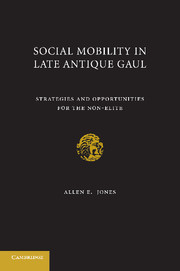Book contents
- Frontmatter
- Contents
- ACKNOWLEDGMENTS
- ABBREVIATIONS
- Gaul in the Late Sixth Century
- CHAPTER ONE INTRODUCTION: BARBARIAN GAUL
- CHAPTER TWO EVIDENCE AND CONTROL
- CHAPTER THREE SOCIAL STRUCTURE I: HIERARCHY, MOBILITY, AND ARISTOCRACIES
- CHAPTER FOUR SOCIAL STRUCTURE II: FREE AND SERVILE RANKS
- CHAPTER FIVE THE PASSIVE POOR: PRISONERS
- CHAPTER SIX THE ACTIVE POOR: PAUPERES AT CHURCH
- CHAPTER SEVEN HEALING AND AUTHORITY I: PHYSICIANS
- CHAPTER EIGHT HEALING AND AUTHORITY II: ENCHANTERS
- CHAPTER NINE CONCLUSION
- BIBLIOGRAPHY
- INDEX
CHAPTER THREE - SOCIAL STRUCTURE I: HIERARCHY, MOBILITY, AND ARISTOCRACIES
Published online by Cambridge University Press: 18 December 2009
- Frontmatter
- Contents
- ACKNOWLEDGMENTS
- ABBREVIATIONS
- Gaul in the Late Sixth Century
- CHAPTER ONE INTRODUCTION: BARBARIAN GAUL
- CHAPTER TWO EVIDENCE AND CONTROL
- CHAPTER THREE SOCIAL STRUCTURE I: HIERARCHY, MOBILITY, AND ARISTOCRACIES
- CHAPTER FOUR SOCIAL STRUCTURE II: FREE AND SERVILE RANKS
- CHAPTER FIVE THE PASSIVE POOR: PRISONERS
- CHAPTER SIX THE ACTIVE POOR: PAUPERES AT CHURCH
- CHAPTER SEVEN HEALING AND AUTHORITY I: PHYSICIANS
- CHAPTER EIGHT HEALING AND AUTHORITY II: ENCHANTERS
- CHAPTER NINE CONCLUSION
- BIBLIOGRAPHY
- INDEX
Summary
Three days ago there departed from us amid general mourning the Lady Philomathia, a dutiful wife and a kind mistress, a busy mother and a devoted daughter, one to whom in social and domestic life her inferior owed respect, her superior consideration, her equal affection.
SIDONIUS APOLLINARIS, Epistula 2.8.1The previous chapter addressed how any understanding of Gallic society will be made difficult because most of the sources derive from a small segment of society, male ecclesiasticalaristocrats. While this control of the evidence demands caution in interpretation, it does not negate the possibility of gaining much insight about how society was structured and how people acted and interacted. Using evidence for Gallic activity – that is, biographical data – over this and the next chapter we shall attempt to construct a model for the society of Barbarian Gaul. A first step toward that model will be to regard images for the structure of society that the producers of our sources advanced. In particular, we shall consider briefly what may be characterized as two independent efforts at “envisioning” society. The first was motivated by secular, indeed royal, concerns, and derives from legal sources, while the second was heavily influenced with ecclesiastical ideas and comes from literary texts. Although the visions expressed in these two kinds of source disagree in particulars, it becomes apparent that socially prominent composers of law and literature shared an opinion that a proper society should be orderly and hierarchical.
- Type
- Chapter
- Information
- Social Mobility in Late Antique GaulStrategies and Opportunities for the Non-Elite, pp. 74 - 128Publisher: Cambridge University PressPrint publication year: 2009



